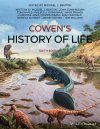Textbook
By: Michael J Benton(Editor), John Cunningham Lilly(Author), Tom Davies(Author), Phillip CJ Donoghue(Author), Andy Fraass(Author), Christine M Janis(Author), Davide Pisani(Author), Emily Rayfield(Author), Daniela Schmidt(Author), Jakob Vinther(Author), Tom Williams(Author)
381 pages, colour & b/w photos, colour & b/w illustrations
![Cowen's History of Life Cowen's History of Life]()
Click to have a closer look
About this book
Contents
Customer reviews
Biography
Related titles
About this book
A newly revised and fully updated edition of the market-leading introduction to palaeontology. For this sixth edition, Richard Cowen, the author of the original five editions published between 1990 to 2013, turned to the palaeontology group at the University of Bristol for help.
Designed for students and anyone else with an interest in the history of life on our planet, the new edition of this classic text describes the biological evolution of Earth's organisms and reconstructs their adaptations and the ecology and environments in which they functioned.
Cowen's History of Life, 6th Edition includes major updates, including substantial rewrites to chapters on the origins of eukaryotes, the Cambrian explosion, the terrestrialization of plants and animals, the Triassic recovery of life, the origin of birds, the end-Cretaceous mass extinction, and human evolution. It also features new chapters on plants, soils and transformation of the land; the Mesozoic marine revolution; and the evolution of oceans and climates. Beginning with the origin of the Earth and the earliest life on earth, Cowen's History of Life goes on to offer insightful contributions covering: the evolution of Metazoans; the early vertebrates; life of vertebrates on land; and early amniotes and thermoregulation. Cowen's History of Life also looks at: dinosaur diversity, as well as their demise; early mammals; the rise of modern mammals; the Neogene Savannas; primates; life in the ice ages; and more.
- Covers the breadth of the subject in a concise yet specific way for undergrads with no academic background in the topic
- Reorganizes all chapters to reflect the geological series of events, enabling a new focus on big events
- Updated with three brand new chapters and numerous revised ones
- Put together by a new editorial team internationally recognized as the global leaders in palaeontology
- Filled with illustrations and photographs throughout
- Includes diagrams to show internal structures of organisms, cladograms, time scales and events, and palaeogeographic maps
- Supplemented with a dedicated website that explores additional enriching information and discussion, and which features images for use in visual presentations
Cowen's History of Life is an ideal book for undergraduate students taking courses in introductory palaeontology, as well those on global change and earth systems.
Contents
Preface vii
About the Companion Website xi
1 The Origin of Life on Earth 1
2 The Earliest Life on Earth 17
3 The Origin of Eukaryotes 33
4 The Evolution of Metazoans 45
5 The Cambrian Explosion 59
6 Changing Life in a Changing World 71
7 The Early Vertebrates 93
8 Leaving the Water 109
9 Early Tetrapods and Amniote Origins 123
10 Early Amniotes and Thermoregulation 137
11 The Mesozoic Marine Revolution 151
12 The Triassic Takeover 169
13 Dinosaurs 181
14 Birds and the Evolution of Flight 203
15 The Cretaceous Terrestrial Revolution 219
16 The End of the Dinosaurs 233
17 Changing Oceans and Climates 245
18 The Origin of Mammals 263
19 Cenozoic Mammals 277
20 Geography and Evolution 297
21 Primates 313
22 Evolving Toward Humans 325
23 Life in the Ice Age 343
Glossary 361
Index 369
Customer Reviews
Biography
Michael J. Benton, PhD, is senior member of the Paleobiology Research Group at the University of Bristol, and is the author of two successful Wiley titles, Vertebrate Palaeontology and Introduction to Paleobiology.
Textbook
By: Michael J Benton(Editor), John Cunningham Lilly(Author), Tom Davies(Author), Phillip CJ Donoghue(Author), Andy Fraass(Author), Christine M Janis(Author), Davide Pisani(Author), Emily Rayfield(Author), Daniela Schmidt(Author), Jakob Vinther(Author), Tom Williams(Author)
381 pages, colour & b/w photos, colour & b/w illustrations
"That this is the sixth edition of Cowen's History of Life since its first edition in 1990 is testament to its value as a source of knowledge over the past 29 years. [...] There is much to commend this book: the straightforward style of writing by leading scholars, the excellent coloured illustrations and photographs, additional reading links and questions for discussion at the end of each chapter, and a companion website offering opportunities for enhanced learning. However, perhaps most notably, it is Cowen's original statement that the book is "meant not just for students, but for everyone interested in the history of life on our planet" that is so poignant today, with climate change and other human activities threatening the rate of species extinction and loss of habitat, and the increasing anger of concerned peoples across the globe. [...]"
– Dr Stephen R. Hoskins, The Biologist 67(1), Feb/Mar 2020






















![Kame no Kōra wa Abarabone: Jintai de Arawasu Ugokumonozukan [Turtle Shells Have Ribs: A Picture Book of Animal Anatomy Represented by the Human Body]](http://mediacdn.nhbs.com/jackets/jackets_resizer_medium/24/249897.jpg?height=150&width=99)











